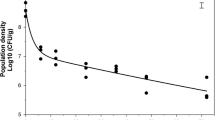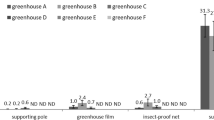Abstract
Eight field surveys over three growing seasons (April to October in 2006, 2007, and 2008) were done in three commercial peach and nectarine orchards in order to determine the secondary inoculum dynamics of Monilinia spp. and relationship to the weather conditions and incidence of postharvest brown rot in the Ebro Valley, which is the main peach fruit growing region in Spain. After regression analysis of the epidemiological data of postharvest brown rot and the climatic variables, a disease outbreak can be predicted from (i) the times of the first appearance of airborne conidia, the first appearance of conidia on the surface of flowers and fruits, and the first latent infection, all of which occur 2 months before harvest (ii) the number of conidia on the fruit surface, 2 weeks and 1 week before harvest, (iii) the preharvest incidence of brown rot, and (iv) the mean environmental temperature from popcorn to harvest. From these results, we confirmed the importance of the secondary inoculum dynamics of Monilinia spp. and the utility of these dynamics to predict an outbreak of brown rot in peaches on the day of their harvest and after their harvesting.



Similar content being viewed by others
References
Bannon, F., Gort, G., van Leeuwen, G., Holb, I., & Jeger, M. (2009). Diurnal patterns in dispersal of Monilinia fructigena conidia in an apple orchard in relation to weather factors. Agricultural and Forest Meteorology, 149, 518–525.
Biggs, A. R., & Northover, J. (1985). Inoculum sources for Monilinia fructicola in Ontario peach orchards. Canadian Journal of Plant Pathology, 7, 302–307.
Biggs, A. R., & Northover, J. (1988). Influence of temperature and wetness duration on infection of peach and sweet cherry fruits by Monilinia fructicola. Phytopathology, 78, 1352–1356.
Byrde, R. J., & Willetts, H. J. (1977). The brown rot fungi of fruit - their biology and control. Oxford: Pergamon.
Corbin, J. B., Ogawa, J. M., & Schultz, H. B. (1968). Fluctuations in numbers of Monilinia laxa conidia in an apricot orchard during the 1966 season. Phytopathology, 58, 1387–94.
Cruickshank, R. H., & Wade, G. C. (1992). The activation of latent infections of Monilinia fructicola on apricots by volatiles from the ripening fruit. Journal of Phytopathology, 136, 107–112.
De Cal, A., & Melgarejo, P. (1999). Effects of long-wave UV light on Monilinia growth and identification of species. Plant Disease, 83, 62–65.
EFSA Panel on Plant Health (PLH). (2011). Pest risk assessment of Monilinia fructicola for the EU territory and identification and evaluation of risk management options. EFSA Journal, 9(4):2119. [155 pp.] doi:10.2903/j.efsa.2011.2119. Retrieved March 2011, from http://www.efsa.europa.eu/efsajournal.
Emery, K. M., Michailides, T. J., & Scherm, H. (2000). Incidence of latent infection of immature peach fruit by Monilinia fructicola and relationship to brown rot in Georgia. Plant Disease, 84, 853–857.
EPPO (2007). List of A2 pests regulated as quarantine pests in the EPPO region. OEPP/EPPO from http://www.eppo.org/QUARANTINE/listA2.htm.
Gell, I., Cubero, J., & Melgarejo, P. (2007). Two different PCR approaches for universal diagnosis of brown rot and identification of Monilinia spp. in stone fruit trees. Journal of Applied Microbiology, 103, 2629–2637.
Gell, I., De Cal, A., Torres, R., Usall, J., & Melgarejo, P. (2008). Relationship between the incidence of latent infections caused by Monilinia spp. and the incidence of brown rot of peach fruit: Factors affecting latent infection. European Journal of Plant Pathology, 121, 487–498.
Gell, I., De Cal, A., Torres, R., Usall, J., & Melgarejo, P. (2009). Conidial density of Monilinia spp. on peach fruit surfaces in relation to the incidences of latent infections and brown rot. European Journal of Plant Pathology, 123, 415–424.
Gupta, Y., & Agarwala, R. K. (1990). Effect of temperature on growth and infection of peach by Monilinia laxa. Plant Disease Research, 6, 76–79.
Hewitt, W. B., & Leach, L. D. (1939). Brown rot Sclerotinias ocurring in California and their distribution on stone fruits. Phytopathology, 29, 337–351.
Holb, I. J. (2008). Monitoring conidial density of Monilinia fructigena in the air in relation to brown rot development in integrated and organic apple orchards. European Journal of Plant Pathology, 120, 397–408.
Koball, D. C., Wilcox, W. F., & Seem, R. C. (1997). Influence of incubation-period humidity on the development of brown rot blossom blight of sour cherry. Phytopathology, 87, 42–49.
Landgraf, F. A., & Zehr, E. I. (1982). Inoculum sources for Monilinia fructicola in South Carolina peach orchards. Phytopathology, 72, 185–190.
Luo, Y., & Michailides, T. J. (2001). Factors affecting latent infection of prune fruit by Monilinia fructicola. Phytopathology, 91, 864–872.
Luo, Y., Michailides, T. J., Morgan, P. D., Krueger, W. H., & Buchner, R. P. (2005). Inoculum dynamics, fruit infection, and development of brown rot in prune orchards in California. Phytopathology, 95, 1132–1136.
Ma, Z., Luo, Y., & Michailides, T. J. (2006). Molecular characterization of the two-component histidine kinase gene from Monilinia fructicola. Pest Management Science, 62, 991–998.
Meier, U., Graf, H., Hess, M., Kennel, W., Klose, R., Mappes, D., Seipp, D., Stauss, R., Streif, J., & van den Boom, T. (1994). Phänologische Entwick-lungsstadien des Kernobstes (Malus domestica Borkh. und Pyrus communis L.), des Steinobstes (Prunus-Arten), der Johannisbeere (Ribes-Arten) und der Erdbeere (Fragaria × ananassa Duch.). Nachrichtenbl. Deut Pflanzenschutzd, 46, 141–153.
Ogawa, J. M., English, W. H., & Wilson, E. E. (1954). Survey for brown rot of stone fruits in California. Plant Disease Reporter, 38, 254–257.
Ogawa, J. M., Zehr, E. I., & Biggs, A. R. (1995). Brown Rot. Pages 7–10. In M. Ogawa, E. I. Zehr, G. W. Bird, D. F. Ritchie, K. Uriu, & J. K. Uyemoto (Eds.), Compendium of stone fruit disease. St. Paul: American Phytopathological Society.
Phillips, D. J. (1984). Effect of temperature on Monilinia fructicola spores produced on fresh stone fruits. Plant Disease, 68, 610–612.
Sagasta, M. E. (1977). Monilinia disease. EPPO Bulletin, 7, 105–116.
Sauer, D. B., & Burroughs, R. (1986). Disinfection of seed surfaces with sodium hypochlorite. Phytopathology, 76, 745–749.
Snedecor, G. W., & Cochram, W. G. (1980). Statistical methods (7th ed.). Ames: Iowa State University.
Tian, S. P., & Bertolini, P. (1999). Effect of temperature during conidial formation of Monilinia laxa on conidial size, germination and infection of stored nectarines. Journal of Phytopathology- Phytopathologische Zeitschrift, 147, 635–641.
Villarino, M., Melgarejo, P., Usall, J., Segarra, J., & De Cal, A. (2010). Primary inoculum sources of Monilinia spp. in Spanish peach orchards and their relative importance in Brown rot. Plant Disease, 94, 1048–1054.
Villarino, M., Sandin-España, P., Melgarejo, P., & De Cal, A. (2011). High Chlorogenic and Neochlorogenic Acid Levels in Immature Peach Reduce Monilinia laxa Infection by Interfering with Fungal Melanin Biosynthesis. Journal of Agricultural and Food Chemistry, 59(7), 3205–3213.
Watson, W. A., Zehr, E. I., & Grimes, L. W. (2002). Influence of temperature and wetting period on inoculum production by Monilinia fructicola in peach twig cankers. Plant Disease, 86, 666–668.
Weaver, L. O. (1950). Effect of temperature and relative humidity on occurrence of blossom blight of stone fruits. Phytopathology, 40, 1136–1153.
Xu, X. M., Guerin, L., & Robinson, J. D. (2001). Effects of temperature and relative humidity on conidial germination and viability, colonization and sporulation of Monilinia fructigena. Plant Pathology, 50, 561–568.
Xu, X. M., Bertone, C., & Berrie, A. (2007). Effects of wounding, fruit age and wetness duration on the development of cherry brown rot in the UK. Plant Pathology, 56, 114–119.
Zehr, E. I. (1982). Control of brown rot in peach orchards. Plant Disease Reporter, 66, 1101–1105.
Acknowledgements
This study was supported by grants AGL2008-00341-CO2 and RTA2005-00077-CO2 from the Ministry of Science and Innovation (Spain). M. Villarino received a scholarship from INIA (Spain). We thank M.T. Morales Clemente and R. Castillo for technical support, and the peach growers for their support and collaboration. The authors also wish to thank Dr. Arieh Bomzon, Consulwrite (www.consulwrite.com) for his editorial assistance in preparing this manuscript.
Author information
Authors and Affiliations
Corresponding author
Rights and permissions
About this article
Cite this article
Villarino, M., Melgarejo, P., Usall, J. et al. Secondary inoculum dynamics of Monilinia spp. and relationship to the incidence of postharvest brown rot in peaches and the weather conditions during the growing season. Eur J Plant Pathol 133, 585–598 (2012). https://doi.org/10.1007/s10658-011-9931-y
Accepted:
Published:
Issue Date:
DOI: https://doi.org/10.1007/s10658-011-9931-y




